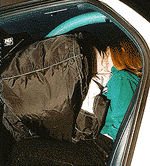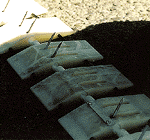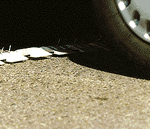-
Hot Shots: Thermal and Magnetosphere Guns
-
Variations on Captain Kirk's phaser, these guns deliver a temporary and completely reversible whammy. The thermal gun raises the target's body temperature to between 105 and 107 degrees Fahrenheit, creating an instant and incapacitating fever. The magnetophosphene gun achieves the same effect as a blow to the head--disorientation--without the accompanying pain.
Most details about these weapons, the products of a development effort sponsored by the Department of Justice, remain classified, including exactly what kind of beam or substance they emit. Sources speculate that the technologies involved may not meet the requirements of the Geneva Convention or the Supreme Court's Tennessee v. Gardner decision, which prohibits the use of lethal or invasive force against a suspect.
-
Shock Therapy: Stun Guns
-
Perhaps the most exotic example of stun technology under development is the electrified water stun gun from JAYCOR in San Diego, California. This high-tech water pistol delivers an electric shock to its human target by mixing mineral-laced water with a high-voltage alternating current. The water provides a way to get the current to the target over long distances, and the minerals in it conduct the current (normal tap water doesn't contain enough conductive compounds to do so). The rest is simple physics: The circuit that's been created tries to find a way to close, so the current discharges into the ground--through the target, who receives a fairly mild shock. Because the current carries a high voltage, it can penetrate through most protective clothing.
Lawrence Livermore National Laboratory in Livermore, California, and Olin Ordnance in St. Petersburg, Florida, are working on a somewhat more prosaic stun gun. Livermore has turned its attention to the launcher itself, while Olin has tackled the rubber ammunition that the gun fires.
Because rubber ammunition can be fatal at short ranges, Livermore wants to find a way to control the force with which the bullet leaves the launcher so that it varies according to the distance of the target. Toward that end, the Livermore team is concocting a laser range finder and a microcontroller that can be mounted on a conventional gun or projectile launcher. The range finder determines how far away the target is from the launcher, and the microcontroller calculates the exact amount of force with which to propel the rubber bullet and then transmits the appropriate commands to the launcher. This set-up simplifies aiming, because the microcontroller helps the projectile arc through the air to the target.
Certain characteristics of Olin's rubber stun bullet help it to achieve the desired stun effect. At a certain distance from the target, it expands into a beanbag-like object, which slows its progress through the air, gives it a larger and more effective surface area, and keeps it from penetrating the target's skin.
Olin already produces a stun bullet that's used mainly to tag fleeing suspects. A one-inch-long, soft rubber cylinder filled with either green indelible ink or a dye that will show up only under ultraviolet light, it's fired by a conventional 12-gauge riot shotgun and explodes upon impact, marking the suspect's clothes and skin. At some ranges, the bullet also stuns the target upon impact.
-
High IQ: A Gun Named Rover
-
As many as 12 police officers were killed by their own guns in a recent year, and guerrilla armies frequently capture weapons from fallen soldiers and use them against the soldiers' compatriots. Two years ago, Sandia National Laboratories in Albuquerque, New Mexico, began a project--now completed--to develop a smart gun that can't be fired by anyone other than its authorized user. The researchers came up with five different models to demonstrate various technologies and principles that could be used for used authorization in a firearm, and the National Institute of Justice (NIJ), which funded the project, will decide shortly which will get the go-ahead.
James Bond fans may recall that in the 1987 film "The Living Daylights," 007 carried a gun that used pattern-recognition technology to restrict anyone but him from firing it. Although Sandia investigated many available technologies and did not pick up the idea for a first-candidate system from the film, Bond's gun existed only in the movies until Sandia invented it . Like Bond's gun, the Sandia system takes advantage of certain patterns that are unique to each person--similar to fingerprints. When you close your hand around something--a gun butt, for example--your hand creates a distinct pattern and shape. Sensors on the smart gun are programmed with the authorized user's patterns, and each time someone tries to fire the gun, the sensors automatically compare the programmed patterns to those of the person squeezing the trigger. The gun won't fire unless both patterns fit the profile.
Another system Sandia developed requires the authorized user to wear a radio transceiver while the gun carries a radio tag. The transceiver constantly sends out a signal to the gun's radio tag, which checks to make sure that the transceiver is within a certain range--say, a few inches--before it will allow the gun to fire.
-
Lifeguard and Deadeye
-
Disturbed by mounting gunshot deaths in Sarajevo's Sniper Alley and in their own country's inner-city districts, Dr. Thomas Karr and his team at the Lawrence Livermore National Laboratory in Livermore, California, set out to invent a device that protects against gunfire. They came up with two systems, LifeGuard and DeadEye, that work together to detect and neutralize bullets.
LifeGuard consists of a sensor, a commercial computer, and state-of-the-art software that work together to track bullets traveling at sub- or supersonic speeds and to identify their origins in a matter of milliseconds. In tests, LifeGuard also detected the movement of mortar and 50-millimeter shells.
When connected to LifeGuard, DeadEye takes various measures to identify and incapacitate a shooter and to defend against gunfire. It can snap pictures of the shooter, fire back a nonlethal device, or even knock an artillery shell from the sky before it reaches its target, all in less than a half second.
-
Communication Breakdown: Empty Bombs and High Frequency Radio
-
The destructive power of high-energy radio frequencies (HERF) has been common knowledge for years. At the height of the CB-radio craze in the 1970s, some CB operators who boosted their equipment with powerful amplifiers inadvertently fried other CBs--sometimes permanently--in the immediate vicinity with their transmissions. CD players and computers emit similar fields, interfering with passenger aircraft avionics, although not enough to disable them permanently. That's why flight attendants on commercial flights insist that passengers switch off such devices during take-off and landing.
A device now under development exploits and refines the crude effects of high-energy radio forces. This HERF gun aims high-energy radio frequencies at a specific target, overloading and disabling--temporarily or permanently--its communications, computer, and other electronic equipment. The HERF gun may be used in wartime to disrupt communications, interfere with enemy aircraft's avionics, and cause malfunctions in ground-based transportation.
While we don't recommend trying this at home, HERF guns can be--and have been--constructed with off-the-shelf technology available at Radio Shack for reasonable cost.
Rather than using an amplified signal as the HERF gun does, the electromagnetic pulse transformer (EMP/T) bomb creates an electromagnetic disturbance by setting off a massive explosion. This effect was first experienced after nuclear test blasts. The EMP/T (pronounced "empty") bomb knocks out all electronic equipment within range, rather than limiting its effects to its target. The technology may have already made its way out of the laboratory to the front lines: Sources told OMNI that the Navy used highly classified, nonnuclear EMP/T bombs during Desert Storm to destroy Iraqi electronic systems.
Sticky Air
-
Intended for military use, this technology would help bar access to restricted areas. Smoke canisters would be launched into the air, creating a visual barrier warning the enemy away. Within the smoke-filled area, polymers--which are essentially glue--suspended in the atmosphere would clog aircraft, tank, and other vehicle engines. The government is keeping a tight lid on further details regarding polymer agents.
-
The Jell-O Restraint
-


The air bag, built into the ceiling of a patrol car is activated by a
police officer from the front seat. The bag slowly inflates (as opposed
to the rapid inflation of front seat air bags) and inhibits violent actions
of a person that could cause injury or damage the vehicle.
|
Idaho National Engineering Laboratory engineer Donna Marts and designer Stacey Barker have come up with another tool for police officers, one that will help them control suspects they've collared and deposited in the backseat of their patrol car. Suspects sometimes become violent and may even try to escape, damaging the car and themselves as well. Marts and Barker devised an air-bag restraint that immobilizes the suspect, allowing the officers to stop the car and safely deal with the situation. Unlike collision air bags, which have an explosive, almost instantaneous reaction, this restraint uses very low pressure and continued air flow to inflate the bag. Fighting the air bag is akin to swimming in a pool of Jell-O: It doesn't hurt--but you don't get far.
Like Marts's and Barker's spiked barrier strip, the air-bag restraint went to the National Institute of Justice for final testing last year.
-
Wild Kingdom: Darts of Tranquillity
-
Like the knock-out darts used to subdue wild animals, calmative agents --chemicals that render a person unconscious--can be delivered to a target through a projectile that penetrates the skin. Lawrence Livermore National Laboratory and the U.S. Army Edgewood Chemical Research Development and Engineering Center lead the research efforts, which have identified potentially useful chemicals and are testing them for toxicity. They're also looking at gases as well as liquid knock-out agents.
As with thermal and magnetophosphene guns, calmative agents may violate various weapons conventions and have come under fire by human-rights advocates.
-
The Sound of Disaster
-
Low-frequency sound waves can have some rather nasty physical effects on people, including disorientation, bowel spasms, and loss of balance. Los Alamos National Laboratory in Los Alamos, New Mexico, and Scientific Applications and Research Associates in Huntington Beach, California, are working on generators that emit high-power, low-frequency acoustic beams; the beams can travel over long distances and overpower ambient noise. The debilitating effects of the beams cease as soon as the generators are turned off.
Among the problems facing researchers investigating this technology is how to target and focus the waves so that they don't incapacitate everyone in the vicinity.
All other details remain classified.
-
Dazzlers, Flash Bangs, and Pulsed Light
-
Although the Department of Defense has banned the use of lasers to permanently blind people, a variety of nonlethal weapons use light to induce temporary disorientation. Flash bangs, for instance, are essentially phosphorus grenades that explode on impact, creating lots of noise, bright white light, and--their main drawback--high levels of heat capable of inflicting severe burns.
Dazzlers mimic the effects of flash bangs, except that they're housed in rugged, insulated containers that prevent burns.
A third technology under development by Lawrence Livermore National Laboratory in Livermore, California, uses pulsed light, like strobe lights in a disco, to blind and disorient without the explosive component of dazzlers and flash bangs. The researchers are also working on sophisticated goggles that use liquid crystal display (LCD) technology to darken and lighten the eyepieces as the light pulses on and off, shielding whoever is using the technology from its effects. Reportedly, they've hit a stumbling block in trying to get the LCDs to react quickly enough.
-
Spiked Defense

The barrier strip is streatched across a road with the hollow needles in a retracted or flat position so vehicles can safely drive over strip. The operator remotely activates the system and raises the needles into a vertical postion. As a fleeing vehicle drives over the barrier strip, several of the hollow needles penetrate and stick in the tire and slowly allow air escape. The slow release of air pressure reduces the chance of the driver losing control even at high speeds since there is no tire blowout.

|
-
Some nonlethal weapons use the most cutting-edge technology imaginable, and others use plain common sense. A device that stops suspects fleeing by car falls into the latter category. Developed and designed by Donna Marts and Stacey Barker of the Idaho National Engineering Laboratory (INEL) in Idaho Falls, the retractable spiked barrier strip can be laid across a road in the path of a suspect's car. But how to puncture only the suspect's tires and not those of the police cars in pursuit? Marts's and Barker's design allows law enforcement officials to retract the hollow spikes by remote control, enabling the following cars to pass without harm. Compact and easy to use, it can be deployed in a matter of seconds.
INEL turned prototypes of Marts's and Barker's invention in to the National Institute of Justice for final testing last year.
-
Cattle Call: The Unctuous Attraction of Protein Foam
-
The thought is disgusting: Hooves, horns, cartilage, and other beef by-products ground and whipped into a sludgy concoction just sticky enough to cling to clothes and surfaces like windows and walls. The sheer repulsiveness of the image did not stop M2 Technologies in San Diego, California, however, from providing the product, which was created by Pneumax of Glendale, Arizona. When sprayed over windows, the dark-brown foam blocks visibility. When layered in front of doors, it impedes the progress of those who wish to leave. The protein foam is environmentally safe enough to be eaten, although its developers attest that it tastes terrible. The foam can be wiped off with a rag and a garden hose, and it dries and flakes off like dandruff if left alone.
Although it didn't make the news, this nonlethal weapon came surprisingly close to playing a part in ending the FBI's standoff last spring with the Freemen in Montana. During the standoff, the FBI asked M2 for a nonlethal capable of neutralizing a group of people with minimum force at a range of 3,000 feet.
In the scenario drawn up by M2, the dark brown foam, propelled by a mixture of water and compressed air, would have been sprayed in layers over windows and doorways, where it would have obstructed visibility and access. Law enforcement officials would then have lobbed tear-gas canisters and/or stun grenades into the compound to force the Freemen out of the foamed buildings and the compound itself through one doorway left free and clear.
On their way out, the Freemen would have run into the protein foam, which would not only have slowed them down but would also have caused disorientation and clogged the vents in gas masks that they might have been wearing, forcing them to remove the masks in order to breathe.
According to our sources, the Freemen surrendered before implementation of this scenario could occur.
-
Spice of Life: Pepper Spray
-
It's similar to the stuff women often carry in their purses to ward off attackers --and it works just as well in the hands of federal agents and police. In its latest incarnation, officials have invoked the power of pepper to control groups of people in mob or hostage situations. Pepper sprays, which irritate the mucous membranes, get their sting from oleoresin capsicum (OC), extracted from the hottest chili peppers available. In the most advanced form of the technology, compressed air or another propellant dispenses the pepper solution over a wide area, and nonlethal launchers can be used to hurl canisters of the stuff into enclosed spaces.
M2 Technologies (San Diego, CA) has also been exploring the possibility of blending OC with protein foam.
-
Body Glue
-
Sticky foam comes out of Sandia National Laboratories in Albuquerque, New Mexico. Although outdoor use is affected by wind, which can potentially reduce its range, the foam is effective indoors at ranges of 45-50 feet. The foam coats suspects, immobilizing them. It's so sticky that someone covered with the stuff must be cut out of his clothes to free him. If the foam covers the mouth or nostrils, the suspect can suffocate, leading to objections to its use from human-rights groups, although Steve Scott, Project Manager in charge of the sticky foam project, points out that "Use protocol for operating the guns dictate that material be dispensed at the feet and legs, never exceeding midwaist level." Also, he added, "emergency facial removal procedures and kits have been developed to minimize risk from facial exposure to bulk foam." Scott told OMNI he was unaware of any objections to the use of the foam from human rights groups.

